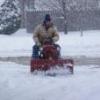By
stevasaurus
My intent here is to show lots of pictures so if anyone is rebuilding one of these or some of the others...you can do it without fear and I am adding some very helpful information. I had a post that lead up to this that has some information in it also, and while it overlaps, I wanted to do the rebuild separate. This post is meant to be used with the manual...the pictures help explain better then the pictures in the manual.
Now I want to share what I learned as I rebuild this...I realize that some have done this, but this was my first time (transmission virgin) and I know I am not the last one to do this. If I can help or make this easier, then I have given back a little from all the help I have received from this site.
Here are a few shots of what this looked like whee I opened the trans. Notice the 1/4" ball bearings on some of the gears. Those are from the #1533 bearings.
This is a shot showing gear placement in the left side of the case. Notice the bevel of the reverse gear (front right). The left side is the shallow side of the transmission halves.
These are the parts of the differential..the 2 casings on the outside, the 2 axles, the differential bull gear, the 4 posts and the pinions that go on these, and the bolts and nuts that hold it all together.
I can't get enough looks at the gears before I tear it apart...next 2 pictures are for future reference.
I found a good assortment of 3/8 and 1/2 sockets that made fair to good arbors for pounding out and tapping in most of the bearings and seals.
These are the bearings and seals you need to do the R&R. You can get all the stuff from Toro or the site that Jason gave in the related post. One note...the Toro#1303 seal is discontinued. This is called a cup seal, because it has a cup shape. I replaced it with a kind of match (SKF #7410) same dimensions but more like a regular oil seal...it will work. This place used to be Berry Bearings in Elgin...now it is "Motion Industries"...the web site MotionMRO.com...they can match up any bearing or seal. Excellent info. and prices were very good.
Shot of the bearings and seals removed, cleaned and sanded. Used Valspar Restoration series...I like the red match with my 702 and I like the hardness of the paint.
Showing bearings and seals installed...notice (arbors on right).
Putting differential back together...show axle in place with bolts in place.
Added pinion posts and in 2nd picture...added pinions (alternating one up and one down).
Added Bull Gear
Added other axle and case and bolted together. At this point, make sure you can rotate the axles...they should rotate in opposite directions.
Placing input shaft and gear (one piece) and the reverse idler shaft.
Installed the 2nd & high shift rail and fork. (one on the left). Also installed both ball bearings, spring and stop pin, and low & reverse shift rail. The 2 sliding gears were then placed...the grooves face each other and the smaller gear goes on the bottom.
I had a pencil magnet that I used to hold the 2nd ball bearing, while I took an Allen wrench through the hole to hold the bearing out of the way while I placed the low and reverse shift rail. the picture also shows the reverse idler and brake shaft in place.
Another view showing forks and gears.
Showing reverse idler (bevel up...I hope) in front. Splined shaft installed through the shift fork sliding gears. The cluster gear is then installed( 2 wood-ruff keys here...one on each end). Also, the differential and axles are placed (note the nuts are facing up).
different angle
yet one more angle
Put together..old 5 gal wood create works great as a work bench (all shafts fit through and keep work level). Used a hard rubber hammer to tap halves together.
No leaks when I filled with 90wt gear oil...approx 1 1/2 qts. Checked shifting and started to put the 702 back together today. A final picture or a video tomorrow (hope).
I want to thank Rickv1957 Fan, MikeRJ, Buckrancher,Suburban550,IndyWH Smokin'Joe, the Helmett and Charlie for all their help and advice...a huge thank you guys.
 By stevasaurus
By stevasaurus